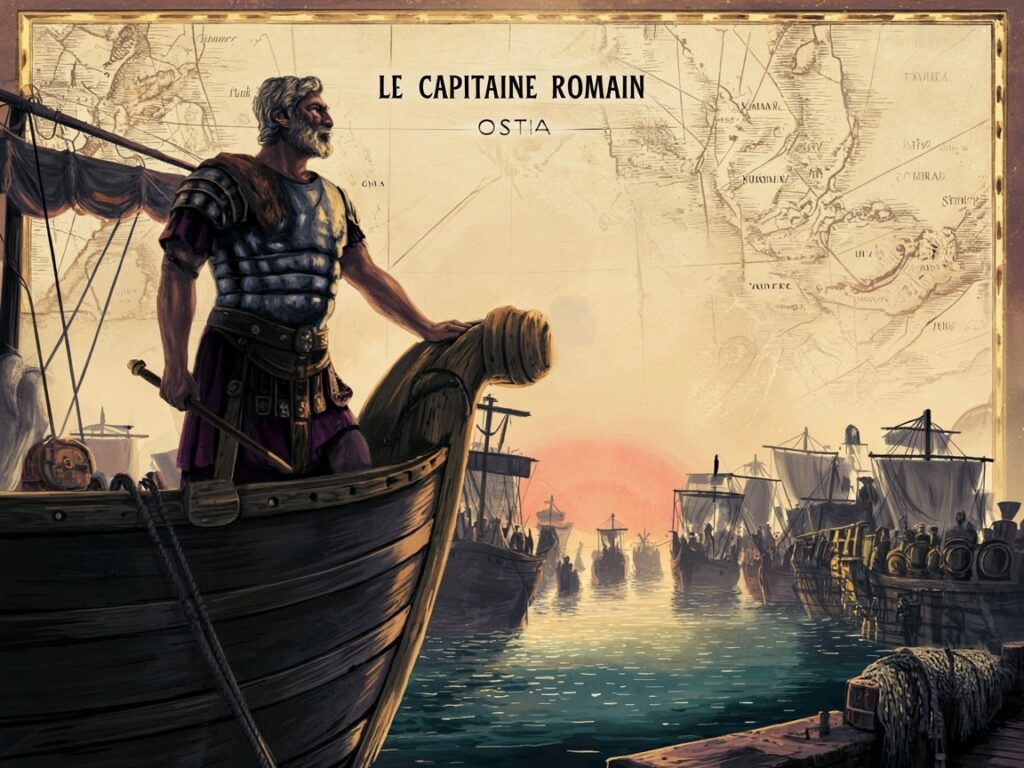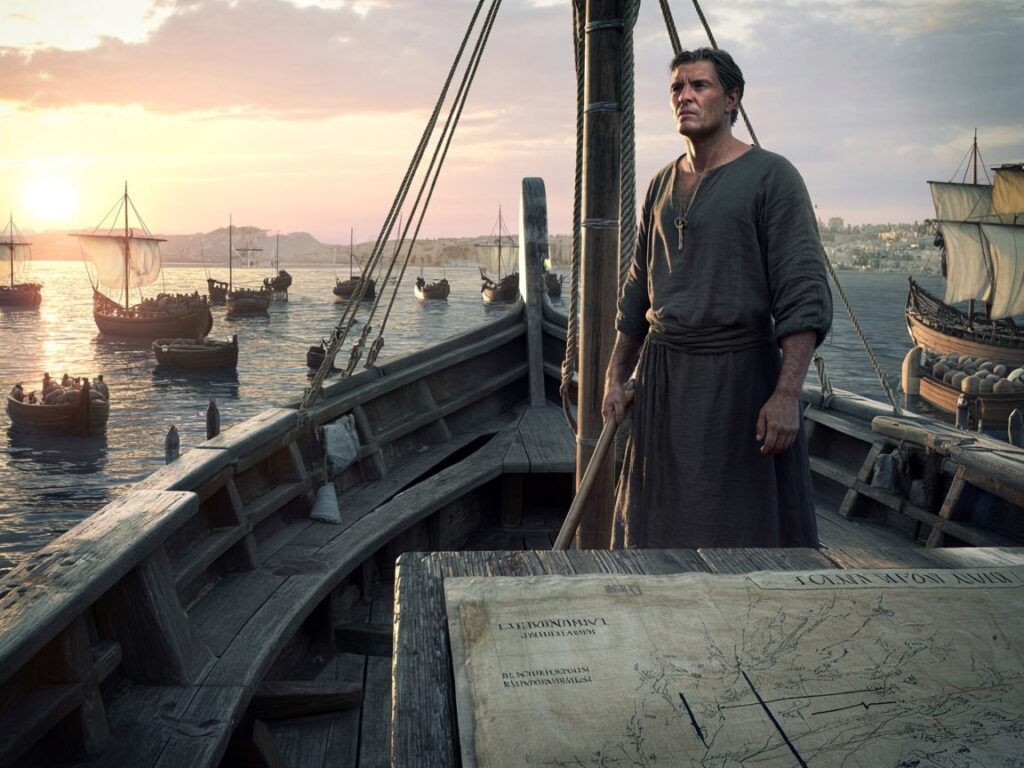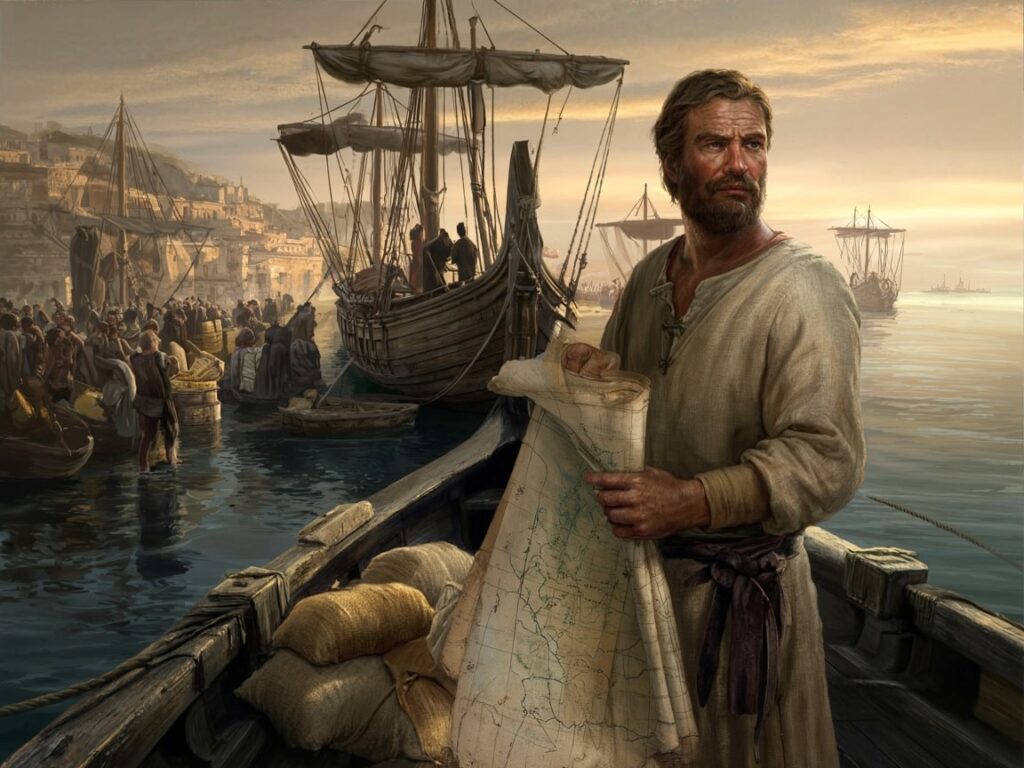The Silent Revolution That Changed Mediterranean Commerce Forever
While history celebrates Rome’s military conquests and architectural feats, the empire’s true power rested upon something far less glamorous but infinitely more important: its commercial networks. At the height of Roman dominance, the Mediterranean wasn’t just a sea – it was the world’s most sophisticated commercial highway, moving goods with an efficiency that wouldn’t be matched for another thousand years. Yet behind this maritime marvel stood not just emperors and generals, but practical innovators whose names history has largely forgotten.
The Mediterranean trade networks that fueled Rome’s prosperity weren’t created by imperial decree. They were painstakingly built by enterprising individuals who saw opportunity where others saw only danger and routine. Among these maritime entrepreneurs, certain captains and merchants developed approaches to commerce that transformed how goods moved throughout the ancient world. Their innovations didn’t just generate personal wealth – they created systems that would define Mediterranean commerce for centuries.
Understanding how these ancient commercial pioneers operated reveals striking parallels to today’s business landscape. The challenges of limited information, uncertain markets, political instability, and fierce competition haven’t fundamentally changed in two millennia. What separated the extraordinarily successful from the merely adequate in ancient commerce mirrors what distinguishes today’s market leaders from their competitors: superior risk assessment, innovative operational approaches, and the ability to build sustainable competitive advantages.
The story that follows examines how one such maritime entrepreneur revolutionized Mediterranean trade through a combination of navigational innovation, logistical brilliance, and diplomatic savvy. His journey from modest shipmaster to commercial visionary demonstrates how entrepreneurial thinking transcends time and technology. More importantly, it reveals timeless principles of business success that remain as relevant in today’s global economy as they were when Rome ruled the ancient world.
From Ordinary Captain to Commercial Visionary
Consider the typical Roman sea captain of the early imperial period – a practical man with modest aspirations. He followed established routes, carried standard cargoes, and viewed success as the safe completion of predictable voyages. Maritime commerce was profitable but perilous, with shipwrecks, pirates, and market fluctuations creating a business environment where survival often meant adhering to proven methods.
Against this backdrop of cautious conventionality, certain captains began to envision different possibilities. They saw the Mediterranean not as a collection of isolated ports and standard routes but as an interconnected network of commercial opportunities waiting to be optimized. These maritime entrepreneurs recognized that the greatest profits lay not in simply moving goods from point A to point B, but in creating entirely new systems of trade that maximized efficiency while minimizing risk.
One such visionary emerged from the bustling port of Ostia in the early first century CE. Starting with a single modest vessel and limited capital, this captain would gradually develop a commercial operation that connected previously isolated markets, introduced novel logistics approaches, and generated profits that astonished his contemporaries. His success wasn’t the result of royal patronage or inherited wealth, but rather came from methodical innovation and a profound understanding of Mediterranean commerce’s underlying dynamics.
What distinguished this captain was his recognition that Rome’s expanding political influence had created unprecedented commercial opportunities for those willing to venture beyond established patterns. As Roman peace brought stability to previously chaotic regions, new markets became accessible. As Roman infrastructure improved ports and roads, logistical efficiencies became possible. And as Roman legal frameworks standardized commercial practices, complex trade arrangements became more reliable.
The captain’s journey from conventional shipmaster to commercial innovator began with a fundamental insight: in a changing world, past practices weren’t just inadequate – they represented missed opportunities. This realization would drive him to reconsider every aspect of Mediterranean trade, from navigation techniques to cargo selection to relationship building. The resulting innovations would create a commercial operation that generated wealth on a scale that few private merchants had ever achieved.

Navigation Innovation: Rewriting the Maps of Possibility
The Mediterranean’s established trade routes had evolved over centuries, shaped by prevailing winds, seasonal patterns, and the limitations of ancient navigation. Most captains followed these traditional pathways without question, seeing them as the only practical options for maritime commerce. Deviating from these routes was considered reckless – an unnecessary risk in an already dangerous profession.
Our entrepreneurial captain recognized something his peers missed: the conventional routes prioritized safety and tradition over efficiency and opportunity. By accepting slightly higher navigational risks, he could dramatically reduce transit times between key ports and access markets during seasons when most captains remained in harbor. This required not just courage but a methodical approach to understanding and managing maritime risks.
The captain invested heavily in gathering navigational knowledge others ignored. He interviewed fishermen from remote coastal communities, meticulously documented weather patterns across multiple seasons, and studied the limitations of existing routes. This research revealed opportunities for seasonal “express routes” that cut diagonal paths across open water rather than hugging coastlines as conventional wisdom dictated.
He developed a sophisticated understanding of Mediterranean wind patterns that allowed his vessels to make passages during months when most shipping halted. While other merchants observed the traditional sailing season from April to October, his ships operated nearly year-round by exploiting predictable wind patterns in what others considered dangerous months. This extended operational calendar meant his capital and vessels remained productive when competitors’ assets sat idle.
Perhaps most importantly, he created detailed navigational charts that transformed accumulated experience into transferable knowledge. Rather than relying solely on a captain’s memory and instinct – the standard practice of the era – his operation used documented routes, landmarks, and techniques that could be taught to new captains. This systematic approach to navigation allowed his fleet to expand without being limited by the number of experienced captains available.
The navigational innovations yielded immediate competitive advantages. His vessels completed up to twice as many voyages annually as conventionally operated ships. They arrived at key ports weeks before competitors, securing premium prices for their cargoes. And they accessed seasonal markets others couldn’t reach, eliminating competition for certain high-value commodities.
Logistical Mastery: The Network Effect in Ancient Commerce
Beyond navigation, the captain’s true genius emerged in his approach to cargo and route planning. Traditional Roman shipping operated on relatively simple principles: vessels carried full loads between major ports, with captains seeking to fill their holds with whatever valuable goods were available at each terminus. This approach was straightforward but inefficient, often resulting in ships traveling partially empty or carrying less-than-optimal cargoes.
The captain developed what modern logistics professionals would recognize as a hub-and-spoke system. Rather than simply shuttling between major ports, his vessels followed carefully orchestrated routes that connected primary commercial centers with smaller, specialized markets. This network approach allowed his ships to carry the most profitable combination of goods available at each point in their journey.
Central to this system was his recognition of the value of information in commercial operations. He established a network of agents at key ports who gathered market intelligence about prices, supply conditions, and demand patterns. These agents communicated through the empire’s courier system and via messages carried by the fleet’s own vessels, creating an information network that provided crucial commercial insights long before competitors received similar news.
Armed with superior market intelligence, the captain could make informed decisions about which goods to transport where and when. If grain prices were spiking in Alexandria due to a poor harvest, his ships could quickly divert with cargoes from surplus regions. If a luxury good was commanding premium prices in a particular market, his vessels could prioritize acquiring and delivering those items. This responsive approach to cargo selection maximized the profit potential of each voyage.
The captain also recognized the value of specialized knowledge in different regional markets. He recruited local commercial experts from various Mediterranean regions, bringing together expertise that spanned from Hispania to Syria. These specialists understood the unique requirements of their native markets – which olive oils were preferred in which regions, which wines commanded premium prices in different cities, which textiles were valued in various provinces.
Perhaps most revolutionary was his approach to vessel utilization. Rather than thinking of ships as independent units, he conceived of his growing fleet as an integrated system where vessels supported each other’s operations. Ships would rendezvous at predetermined locations to transfer cargoes, allowing each vessel to carry the most appropriate goods for its specific route and destination. This systematic approach maximized the value of each ship in his fleet.

Diplomatic Commerce: Building the Ancient World’s First Business Alliances
The captain’s third major innovation concerned relationships with suppliers, customers, and political authorities throughout the Mediterranean. Traditional Roman merchants typically conducted business through straightforward transactions – they purchased goods at one port and sold them at another, with relationships rarely extending beyond individual deals. This transactional approach limited their ability to develop sustainable competitive advantages.
Our maritime entrepreneur recognized that lasting commercial success required something more sophisticated: strategic partnerships that created mutual benefits beyond simple buying and selling. He systematically developed long-term relationships with producers, distributors, and officials throughout the Mediterranean basin, creating a commercial network that provided advantages no competitor could easily replicate.
With key suppliers, he established arrangements that went far beyond standard purchasing. Rather than simply buying olive oil after harvest, for example, he provided financing to producers throughout the growing season in exchange for preferential pricing and first access to the highest quality product. These arrangements benefited producers through financial stability while giving his operation access to premium goods at advantageous prices.
He applied similar partnership approaches with distributors in destination markets. Rather than selling cargoes to whoever offered the highest immediate price, he developed ongoing relationships with established merchants in major cities. These partnerships included exclusivity arrangements, shared market intelligence, and coordinated distribution strategies that benefited both parties while creating barriers to competitor entry.
Perhaps most crucial to his success was his sophisticated approach to navigating the political dimensions of Roman commerce. He cultivated relationships with port officials, tax collectors, and local authorities throughout the Mediterranean, recognizing that these connections could significantly impact commercial operations. By understanding and accommodating the interests of these political stakeholders, he secured preferential treatment that further enhanced his competitive position.
The captain also recognized the value of community relations in port cities where his vessels operated regularly. He made strategic investments in local religious and civic institutions, sponsored public amenities, and supported community initiatives in key commercial hubs. These contributions weren’t merely philanthropic – they generated goodwill that translated into tangible commercial advantages, from better berth assignments to supportive treatment during disputes.
Through these diplomatic approaches to commerce, the captain built something revolutionary: an integrated commercial ecosystem where mutual interests aligned participants toward shared success. This system created advantages that transcended simple efficiency or scale – it established structural barriers to competition that protected his operation’s profitability over the long term.
The Economic Impact: Prosperity Through Innovation
The combined effect of these navigational, logistical, and relational innovations transformed what had begun as a modest shipping operation into the Mediterranean’s most profitable commercial enterprise. While precise financial records haven’t survived, contemporary accounts suggest the scale of economic impact was unprecedented for a private commercial venture not backed by imperial resources.
At its height, the operation reportedly managed a fleet of over two dozen vessels – from nimble liburnians that could navigate shallow harbors to substantial merchant ships capable of carrying bulk grain and timber. This diversified fleet allowed the enterprise to handle virtually any cargo profitably, adapting to seasonal opportunities and market conditions as they emerged.
The operation’s commercial network eventually spanned the entire Mediterranean basin, connecting markets from Gades in the west to Antioch in the east, and from Massilia in the north to Alexandria in the south. This extensive network created economies of scale and scope that no competitor could match, allowing the enterprise to offer more reliable service, greater cargo variety, and often better pricing than alternatives.
The economic impact extended far beyond the captain’s own operation. Producers in previously isolated regions gained access to empire-wide markets through his commercial networks. Consumers in major urban centers received more diverse goods at lower prices thanks to his logistical innovations. And ancillary businesses – from shipbuilders to warehouse operators to financial services – flourished in ports where his vessels operated regularly.
Perhaps most significantly, the captain’s approach demonstrated the enormous potential of systematic, knowledge-driven commerce in the ancient world. While most merchants relied on tradition and intuition, he showed that methodical analysis, strategic planning, and systematic execution could generate returns that dwarfed conventional approaches. This lesson would influence Mediterranean commerce for generations, as others sought to adapt his methods to their own operations.

Timeless Principles for Modern Business Leaders
The story of this Roman maritime entrepreneur contains insights that transcend its ancient context. The fundamental principles that drove his success remain relevant for today’s business leaders facing their own complex competitive landscapes. These timeless lessons include:
Question established practices relentlessly. The captain’s journey began with his willingness to challenge conventional wisdom about navigation, cargo handling, and business relationships. Similarly, today’s most successful enterprises don’t simply accept industry standards – they continuously examine whether established practices truly represent optimal approaches.
Invest in superior information. The ancient trading network’s success depended heavily on better market intelligence and navigational knowledge than competitors possessed. In today’s information economy, competitive advantage similarly flows to organizations that develop superior systems for gathering, analyzing, and deploying relevant knowledge.
Build systems, not just transactions. The captain created an integrated commercial ecosystem rather than merely conducting isolated deals. Modern business leaders likewise create sustainable advantages when they develop interconnected systems that align incentives among stakeholders rather than focusing solely on individual transactions.
Balance innovation with risk management. While the Roman entrepreneur took calculated risks that his competitors avoided, he did so through careful analysis and methodical planning. Today’s most successful innovators similarly balance creative approaches with disciplined risk assessment, finding the productive middle ground between recklessness and excessive caution.
Create stakeholder alignment. The ancient trading operation succeeded partly because it aligned the interests of suppliers, distributors, political authorities, and communities with its own commercial goals. Modern enterprises likewise generate sustainable advantages when they create genuine mutual benefits across their stakeholder ecosystems.
Develop institutional knowledge. By documenting navigational insights and systematizing commercial practices, the captain created an operation that transcended dependence on any individual’s expertise. Today’s organizations similarly build lasting value when they transform individual knowledge into institutional capabilities that can be preserved and transferred.
Recognize opportunity in changing conditions. The captain’s innovations were made possible partly by Rome’s expanding influence, which created new commercial possibilities for those alert enough to recognize them. Contemporary business leaders likewise find their greatest opportunities during periods of significant change, when established patterns are disrupted and new approaches become possible.
The Legacy of Maritime Innovation
The trading network created by our entrepreneurial captain wouldn’t last forever. Eventually, changing political conditions, new competitors adapting his methods, and the natural lifecycle of commercial enterprises would erode the operation’s exceptional profitability. Yet the impact of his innovations would endure long after his personal commercial empire faded.
The navigational techniques he pioneered would become standard practice for Mediterranean shipping, incorporated into the practical knowledge passed between generations of mariners. His hub-and-spoke approach to cargo management would influence logistical thinking throughout the Roman world and beyond. And his systematic approach to commercial relationships would provide a template for successful merchants across the empire.
More fundamentally, his example demonstrated the transformative potential of entrepreneurial thinking applied to established industries. He showed that even in ancient commerce – an arena where tradition held tremendous force – innovative approaches could create extraordinary results. This lesson transcends its historical context, speaking directly to modern business leaders facing their own entrenched industries and conventional wisdom.
The story of this Roman maritime entrepreneur reminds us that the fundamental drivers of commercial success haven’t changed as much as we might imagine. Despite our technological advances and complex economic systems, business still revolves around identifying unmet needs, developing more efficient solutions, and creating value through innovation. The methods may evolve, but the principles endure.
Perhaps most importantly, this ancient case study demonstrates that entrepreneurial thinking isn’t unique to our era or dependent on modern technology. The capacity to envision different possibilities, challenge established practices, and implement systematic innovations is a fundamentally human capability that has driven progress throughout history. By studying how these qualities manifested in different historical contexts, we gain deeper insight into their essential nature and universal application.
As we navigate our own complex commercial landscapes, we would do well to remember this forgotten Roman innovator who reimagined what was possible in his world. His willingness to question convention, his systematic approach to knowledge, and his ability to build lasting competitive advantages through relationship networks offer a blueprint for entrepreneurial success that remains as relevant today as it was when his vessels sailed the ancient Mediterranean.

